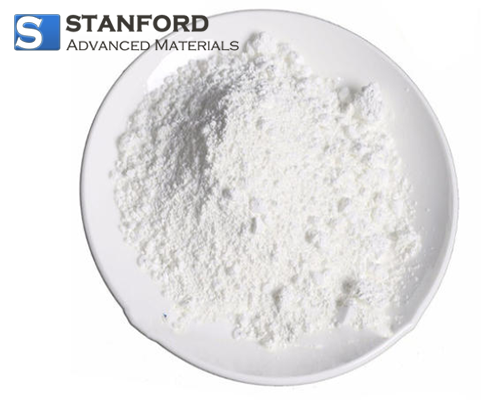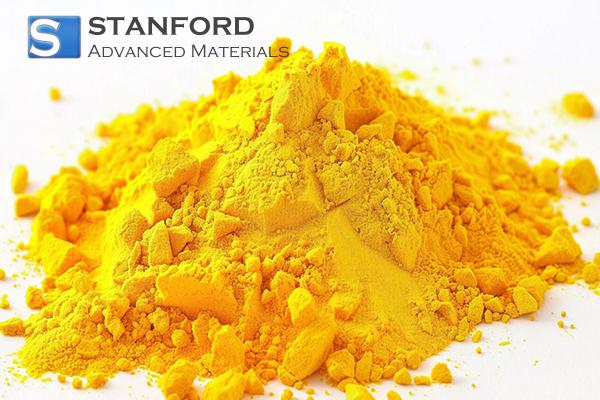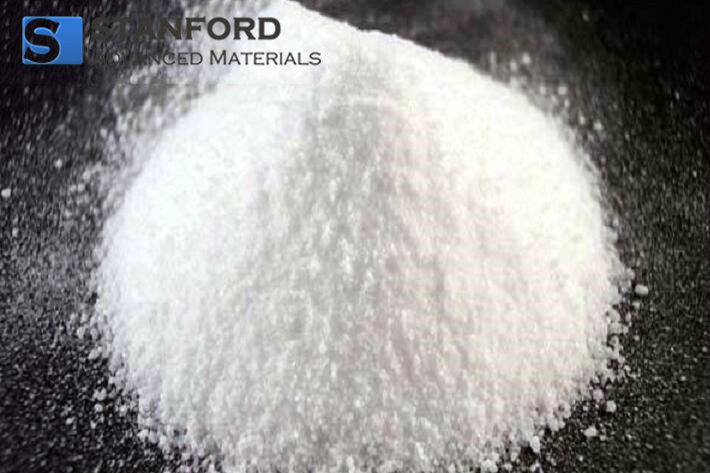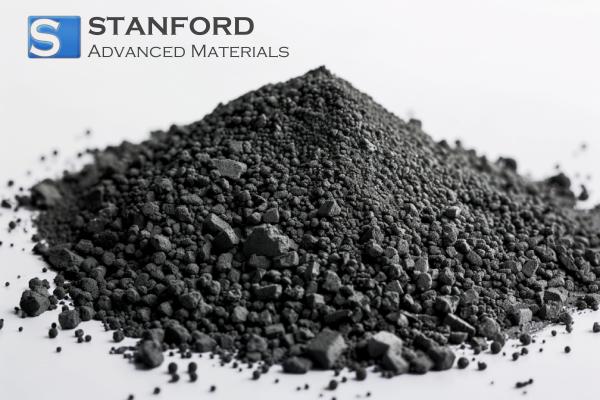SECTION 1. IDENTIFICATION
Product Name: Lithium Hydride
CAS #: 7580-67-8
Relevant identified uses of the substance: Scientific research and development
Supplier details:
Stanford Advanced Materials
E-mail: sales@samaterials.com
Tel: (949) 407-8904
Address: 23661 Birtcher Dr., Lake Forest, CA 92630 U.S.A.
SECTION 2. HAZARDS IDENTIFICATION
Classification of the substance or mixture in accordance with 29 CFR 1910 (OSHA HCS)
GHS02 Flame
Water-react. 1 H260 In contact with water releases flammable gases which may ignite spontaneously.
GHS06 Skull and crossbones
Acute Tox. 3
H301 Toxic if swallowed.
GHS05 Corrosion
Skin Corr. 1B H314 Causes severe skin burns and eye damage.
Eye Dam. 1
H318 Causes serious eye damage.
Hazards not otherwise classified
No information known.
Label elements
GHS label elements
The product is classified and labeled in accordance with 29 CFR 1910 (OSHA HCS)
Hazard pictogram
GHS02 GHS05 GHS06
Signal word: Danger
Hazard statements
H260 In contact with water releases flammable gases which may ignite spontaneously.
H301 Toxic if swallowed.
H314 Causes severe skin burns and eye damage.
Precautionary statements
P231+P232 Handle under inert gas. Protect from moisture.
P301+P310 IF SWALLOWED: Immediately call a POISON CENTER/ doctor/...
P303+P361+P353 If on skin (or hair): Take off immediately all contaminated clothing. Rinse skin with
water/shower.
P305+P351+P338 IF IN EYES: Rinse cautiously with water for several minutes. Remove contact
lenses, if present and easy to do. Continue rinsing.
P405 Store locked up.
P501 Dispose of contents/container in accordance with local/regional/national/international
regulations.
WHMIS classification
B6 - Reactive flammable material
D1A - Very toxic material causing immediate and serious toxic effects
D2B - Toxic material causing other toxic effects
E - Corrosive material
Classification system
HMIS ratings (scale 0-4)
(Hazardous Materials Identification System)
HEALTH
FIRE
REACTIVITY
3
3
3
Health (acute effects) = 3
Flammability = 3
Physical Hazard = 3
Other hazards
Results of PBT and vPvB assessment
PBT: Not applicable.
vPvB: Not applicable.
SECTION 3. COMPOSITION/INFORMATION ON INGREDIENTS
Chemical characterization: Substances
CAS# Description:
7580-67-8 Lithium hydride
Identification number(s):
EC number:
231-484-3
SECTION 4. FIRST AID MEASURES
Description of first aid measures
General informationImmediately remove any clothing soiled by the product.
In case of irregular breathing or respirat
ory arrest provide artificial respiration.
After inhalation
Supply fresh air. If required, provide arti
ficial respiration. Keep patient warm.
Seek immediate medical advice.
After skin contact
Immediately wash with water and soap and rinse thoroughly.
Seek immediate medical advice.
After eye contact
Rinse opened eye for several minutes under
running water. Then consult a doctor.
After swallowing
Do not induce vomiting; immediately call for medical help.
Information for doctor
Most important symptoms and effects, both acute and delayed
Causes severe skin burns.
Causes serious eye damage.
Indication of any immediate medical attention and special treatment needed
No further relevant information available.
SECTION 5. FIREFIGHTING MEASURES
Description of first aid measures
General information
Immediately remove any clothing soiled by the product.
In case of irregular breathing or respiratory arrest provide artificial respiration.
After inhalation
Supply fresh air. If required, provide artificial respiration. Keep patient warm.
Seek immediate medical advice.
After skin contact
Immediately wash with water and soap and rinse thoroughly.
Seek immediate medical advice.
After eye contact
Rinse opened eye for several minutes under
running water. Then consult a doctor.
After swallowing
Do not induce vomiting; immediately call for medical help.
Information for doctor
Most important symptoms and effects, both acute and delayed
Causes severe skin burns.
Causes serious eye damage.
Indication of any immediate medical attention and special treatment needed
No further relevant information available.
SECTION 6. ACCIDENTAL RELEASE MEASURES
Personal precautions, protective equipment and emergency procedures
Wear protective equipment. Keep unprotected persons away.
Ensure adequate ventilationKeep away from ignition sources
Environmental precautions:
Do not allow product to reach sewage system or any water course.
Methods and material for containment and cleaning up:
Use neutralizing agent.
Dispose of contaminated material as waste according to section 13.
Ensure adequate ventilation.
Do not flush with water or aqueous cleansing agents
Prevention of secondary hazards:
Keep away from ignition sources.
Reference to other sections
See Section 7 for information on safe handling
See Section 8 for information on personal protection equipment.
See Section 13 for disposal information.
SECTION 7. HANDLING AND STORAGE
Handling
Precautions for safe handling
Handle under dry protective gas.
Keep container tightly sealed.
Store in cool, dry place in tightly closed containers.
Ensure good ventilation at the workplace.
Information about protection against explosions and fires:
Protect against electrostatic charges.
Conditions for safe storage, including any incompatibilities
Storage
Requirements to be met by storerooms and receptacles:
No special requirements.
Information about storage in one common storage facility:
Store away from air.
Store away from water/moisture.
Do not store together with acids.
Store away from oxidizing agents.
Store away from alcohols.
Further information about storage conditions:
Store under dry inert gas.
This product is moisture sensitive.
This product is air sensitive.
Protect from humidity and water.
Keep container tightly sealed.
Store in cool, dry conditions in well sealed containers.
Specific end use(s)
No further relevant information available.
SECTION 8. EXPOSURE CONTROLS/PERSONAL PROTECTION
Additional information about design of technical systems:
Properly operating chemical fume hood designed for hazardous chemicals and having an average
face velocity of at least 100 feet per minute.
Control parametersComponents with limit values that require monitoring at the workplace:
7580-67-8 Lithium hydride (100.0%)
PEL (USA)
Long-term value: 0.025 mg/m³
REL (USA)
Long-term value: 0.025 mg/m³
TLV (USA)
Long-term value: 0.025 mg/m³
EL (Canada) Long-term value: 0.025 mg/m³
EV (Canada) Long-term value: 0.025 mg/m³
Additional information:
No data
Exposure controls
Personal protective equipment
General protective and hygienic measures
The usual precautionary measures for handling chemicals should be followed.
Keep away from foodstuffs, beverages and feed.
Remove all soiled and contaminated clothing immediately.
Wash hands before breaks and at the end of work.
Avoid contact with the eyes and skin.
Maintain an ergonomically appropriate working environment.
Breathing equipment:
Use suitable respirator when high concentrations are present.
Recommended filter device for short term use:
Use a respirator with type P100 (USA) or P3 (EN 143) cartridges as a backup to engineering controls.
Risk assessment should be performed to determine if air-purifying respirators are appropriate. Only
use equipment tested and approved under appropriate government standards.
Protection of hands:
Impervious gloves
Check protective gloves prior to each use for their proper condition.
The selection of suitable gloves not only
depends on the material, but also on quality. Quality will vary from manufacturer to manufacturer.
Material of gloves
Nitrile rubber, NBR
Penetration time of glove material (in minutes)
Not determined
Eye protection:
Tightly sealed goggles
Full face protection
Body protection:
Protective work clothing.
SECTION 9. PHYSICAL AND CHEMICAL PROPERTIES
Information on basic physical and chemical properties
General Information
Appearance:
Form:
Powder
Color:
White to grey
Odor:
OdorlessOdor threshold:
Not determined.
pH-value:
Not applicable.
Change in condition
Melting point/Melting range:
688 °C (1270 °F)
Boiling point/Boiling range:
Not determined
Sublimation temperature / start:
Not determined
Flammability (solid, gaseous)
Contact with water liberates extremely flammable gases.
Ignition temperature:
Not determined
Decomposition temperature:
Not determined
Auto igniting:
Not determined.
Danger of explosion:
Not determined.
Explosion limits:
Lower:
Not determined
Upper:
Not determined
Vapor pressure at 20 °C (68 °F):
0 hPa
Density at 20 °C (68 °F):
0.78 g/cm³ (6.509 lbs/gal)
Relative density
Not determined.
Vapor density
Not applicable.
Evaporation rate
Not applicable.
Solubility in / Miscibility with
Water:
Reacts violently
Contact with water releases flammable gases
Alcohols:
Reacts
Partition coefficient (n-octanol/water):
Not determined.
Viscosity:
dynamic:
Not applicable.
kinematic:
Not applicable.
Other information
No further relevant information available.
SECTION 10. STABILITY AND REACTIVITY
Reactivity
Reacts violently with water.
In contact with water releases flammable gases which may ignite spontaneously.
Chemical stability
Stable under recommended storage conditions.
Thermal decomposition / conditions to be avoided:
Decomposition will not occur if used and stored according to specifications.
Possibility of hazardous reactions
Reacts with strong oxidizing agents
Contact with water releases flammable gases
Reacts violently with water
Conditions to avoid
No further relevant information available.
Incompatible materials:
Acids
Air
Oxidizing agents
Alcohols
Water/moisture
Hazardous decomposition products:
Hydrogen
Lithium oxide
SECTION 11. TOXICOLOGICAL INFORMATION
Information on toxicological effects
Acute toxicity:
Toxic if swallowed.
Swallowing will lead to a strong corrosive effect on mouth and throat and to the danger of perforation
of esophagus and stomach.
The Registry of Toxic Effects of Chemical Substances (RTECS) contains acute toxicity data for this
substance.
LD/LC50 values that are relevant for classification:
Oral LD50 77.5 mg/kg (rat)
Skin irritation or corrosion:
Causes severe skin burns.
Eye irritation or corrosion:
Causes serious eye damage.
Sensitization:
No sensitizing effects known.
Germ cell mutagenicity:
No effects known.
Carcinogenicity:
No classification data on carcinogenic properties of this material is available from the EPA, IARC,
NTP, OSHA or ACGIH.
Reproductive toxicity:
No effects known.
Specific target organ system toxicity - repeated exposure:
No effects known.
Specific target organ system toxicity - single exposure:
No effects known.Aspiration hazard:
No effects known.
Subacute to chronic toxicity:
The Registry of Toxic Effects of Chemical Substances (RTECS) contains multiple dose toxicity data for
this substance.
Additional toxicological information:
To the best of our knowledge the acute and chronic toxicity of this substance is not fully known.
SECTION 12. ECOLOGICAL INFORMATION
Toxicity
Aquatic toxicity:
No further relevant information available.
Persistence and degradability
No further relevant information available.
Bioaccumulative potential
No further relevant information available.
Mobility in soil
No further relevant information available.
Additional ecological information:
General notes:
Do not allow product to reach ground water, water course or sewage system.
Danger to drinking water if even small quantities leak into the ground.
Avoid transfer into the environment.
Results of PBT and vPvB assessment
PBT:
Not applicable.
vPvB:
Not applicable.
Other adverse effects
No further relevant information available.
SECTION 13. DISPOSAL CONSIDERATIONS
Waste treatment methods
Recommendation
Consult state, local or national regulations to ensure proper disposal.
Uncleaned packagings:
Recommendation:
Disposal must be made according to official regulations.
SECTION 14. TRANSPORT INFORMATION
UN-Number
DOT, IMDG, IATA
UN1414
UN proper shipping name
DOT
Lithium hydride
IMDG, IATALITHIUM HYDRIDE
Transport hazard class(es)
DOT
Class
4.3 Substances which, in contact with water, emit flammable gases.
Label
4.3
Class
4.3 (W2) Substances which, in contact with water, emit flammable gases
Label
4.3
IMDG, IATA
Class
4.3 Substances which, in contact with water, emit flammable gases.
Label
4.3
Packing group
DOT, IMDG, IATA
I
Environmental hazards:
Not applicable.
Special precautions for user
Warning: Substances which, in contact with water, emit flammable gases
EMS Number:
F-G,S-N
Transport in bulk according to Annex II of MARPOL73/78 and the IBC Code
Not applicable.
Transport/Additional information:
DOT
Marine Pollutant (DOT):
No
UN "Model Regulation":
UN1414, Lithium hydride, 4.3, I
SECTION 15. REGULATORY INFORMATION
Safety, health and environmental regulations/legislation specific for the substance or mixture
GHS label elements
The product is classified and labeled in accordance with 29 CFR 1910 (OSHA HCS)
Hazard pictograms
GHS02
GHS05
GHS06
Signal word
Danger
Hazard statements
H260 In contact with water releases flammable gases which may ignite spontaneously.
H301 Toxic if swallowed.
H314 Causes severe skin burns and eye damage.
Precautionary statements
P231+P232
Handle under inert gas. Protect from moisture.
P301+P310IF SWALLOWED: Immediately call a POISON CENTER/ doctor/...
P303+P361+P353 If on skin (or hair): Take off immediately all contaminated clothing. Rinse skin with
water/shower.
P305+P351+P338 IF IN EYES: Rinse cautiously with water for several minutes. Remove contact
lenses, if present and easy to do. Continue rinsing.
P405
Store locked up.
P501
Dispose of contents/container in accordance with local/regional/national/international regulations.
National regulations
All components of this product are listed in the U.S. Environmental Protection Agency Toxic
Substances Control Act Chemical substance Inventory.
All components of this product are listed on the Canadian Non-Domestic Substances List (NDSL).
SARA Section 313 (specific toxic chemical listings)
Substance is not listed.
California Proposition 65
Prop 65 - Chemicals known to cause cancer
Substance is not listed.
Prop 65 - Developmental toxicity
Substance is not listed.
Prop 65 - Developmental toxicity, female
Substance is not listed.
Prop 65 - Developmental toxicity, male
Substance is not listed.
Information about limitation of use:
For use only by technically qualified individuals.
Other regulations, limitations and prohibitive regulations
Substance of Very High Concern (SVHC) according to the REACH Regulations (EC) No. 1907/2006.
Substance is not listed.
The conditions of restrictions according to Article 67 and Annex XVII of the Regulation (EC) No
1907/2006 (REACH) for the manufacturing, placing on the market and use must be observed.
Substance is not listed.
Annex XIV of the REACH Regulations (requiring Authorisation for use)
Substance is not listed.
Chemical safety assessment:
A Chemical Safety Assessment has not been carried out.
SECTION 16. OTHER INFORMATION
Safety Data Sheet according to Regulation (EC) No. 1907/2006 (REACH). The above information is
believed to be correct but does not purport to be all inclusive and shall be used only as a guide. The
information in this document is based on the present state of our knowledge and is applicable to the
product with regard to appropriate safety precautions. It does not represent any guarantee of the
properties of the product.


 English
English Española
Española Deutsch
Deutsch Français
Français Italiano
Italiano
 GHS02
GHS02 GHS05
GHS05 GHS06
GHS06






